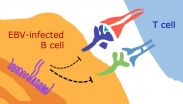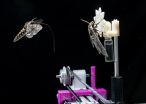(Press-News.org) A 1995 Connecticut law requiring a permit or license - contingent on passing a background check - in order to purchase a handgun was associated with a 40 percent reduction in the state's firearm-related homicide rate, new research suggests.
Researchers from the Johns Hopkins Center for Gun Policy and Research, part of the Johns Hopkins Bloomberg School of Public Health, compared Connecticut's homicide rates during the 10 years following the law's implementation to the rates that would have been expected had the law not been implemented. The large drop in homicides was found only in firearm-related killings, not in homicides by other means, as would be expected if the law drove the reduction.
The findings are published online June 11 in the American Journal of Public Health, and will be discussed at a press conference hosted by Faiths United Against Gun Violence at the National Cathedral in Washington on June 11 at 4 p.m.
The Connecticut law requires all prospective handgun purchasers to apply for a permit in person with the local police regardless of whether the seller of the handgun is a licensed dealer or private seller. It also raised the handgun purchasing age from 18 to 21 years and required prospective purchasers to complete at least eight hours of approved handgun safety training.
"Permit-to-purchase laws, which require prospective handgun purchasers to first obtain a license from the police after passing a comprehensive background check, appear to reduce the availability of handguns to criminals and other people who are not legally permitted to buy guns," says study author Daniel Webster, ScD, MPH, director of the Johns Hopkins Center for Gun Policy and Research. "Licensing handgun purchasers is a particularly effective way to achieve comprehensive background checks and keep people from buying guns for people who are not legally allowed to own them."
Earlier research from Webster found that Missouri's 2007 repeal of its handgun license law was associated with a 25 percent increase in its firearm homicide rates. For the Connecticut study, Webster and his colleagues used comparison states with homicide trends that most closely matched those in Connecticut before the law went into effect in order to predict what would have happened to homicide trends in Connecticut had the handgun licensing law not been implemented.
"Taken together, these studies provide compelling evidence that permit to purchase licensing systems is one of the most effective policies we have to reduce gun violence," Webster says.
Ten states plus the District of Columbia have handgun purchaser licensing laws. While state laws vary, in general, handgun purchaser laws work by requiring background checks for all gun sales (including private, unlicensed sellers), and put the responsibility of conducting the background check on local law enforcement, not the gun seller.
"Research suggests that requiring in-person applications at law enforcement agencies may make it harder for individuals with a history of violence and criminality to get guns," says study co-author Jon Vernick, JD, MPH, co-director of the Johns Hopkins Center for Gun Policy and Research. "Future research should compare the effectiveness of requiring prospective gun purchasers to go to federally licensed gun dealers for a background check versus local law enforcement agencies."
Public opinion survey data from Webster and his colleagues recently published in Preventive Medicine show that the majority of Americans (72 percent) and gun owners (59 percent) support requiring people to obtain a license from a local law enforcement agency before buying a handgun to verify their identity and ensure they are not legally prohibited from having a gun.
INFORMATION:
"Association Between Connecticut's Permit-to-Purchase Handgun Law and Homicides" is written by Kara E. Rudolph, PhD, MPH, MHS; Elizabeth A. Stuart, PhD; Jon S. Vernick, JD, MPH; and Daniel W. Webster, ScD, MPH. The study was funded by a grant from the Joyce Foundation.
Boston, MA - More than half of all children and adolescents in the U.S. are not getting enough hydration--probably because they're not drinking enough water--a situation that could have significant repercussions for their physical health and their cognitive and emotional functioning, according to the first national study of its kind from Harvard T.H. Chan School of Public Health.
The study also found racial/ethnic and gender gaps in hydration status. Black children and adolescents were at higher risk of inadequate hydration than whites; boys were at higher risk than girls.
The ...
Though many people believe they can recognize when someone is lying, detecting deception is difficult. Accuracy rates in experiments have proven to be only slightly greater than chance, even among trained professionals.
But a new study published recently in Proceedings of the National Academy of Sciences (PNAS) finds that groups are consistently more accurate in distinguishing truths from lies than one individual is.
In 'Group discussion improves lie detection,' by University of Chicago Booth School of Business Professor Nicholas Epley and Chicago Booth doctoral student ...
Not all of America's most admired companies are killing it on social media. In fact, some are almost flat lining, according to a team of researchers.
Several firms on Fortune Magazine's list of America's most admired companies are failing to achieve basic social media standards, let alone best practices, according to Marcia DiStaso, associate professor of public relations, Penn State.
"We were surprised that not all the companies had a Twitter account, for instance, and not every company had a Facebook page, or a YouTube page," said DiStaso. "There are top companies ...
Beverly, MA, June 11, 2015 - Cardiac surgeons often "crack open" the flat bone that forms the middle front section of the chest, known as the sternum, in order to reach important structures. When a sternal wound infection (SWI) occurs, serious complications and even death may result. Implanting antibiotic-laden sponges between the sternal halves before closure has been adapted to prevent infections. While a recent report questioned this practice, a meta-analysis in The Journal of Thoracic and Cardiovascular Surgery, the official publication of the American Association for ...
Nursing home residents with dementia are less likely to be apathetic if they live in an appropriately stimulating environment, according to nursing researchers.
Nearly half of all residents in nursing homes have dementia, according to a 2013 report by the Centers for Disease Control. Apathy is one of the most common neurobehavioral symptoms in dementia, with about 90 percent of older adults with dementia experiencing it. Those with mild dementia will decline more quickly into severe dementia if they also suffer from apathy, making it important to help them stay engaged. ...
Lehigh University engineers, materials scientists and chemists will present their innovative breakthroughs to a national showcase of investors and industrial partners at the TechConnect 2015 World Innovation Conference and National Innovation Showcase in Washington on June 14-17.
Working at the junction of engineering and health, the Lehigh innovations include a nanoscale device that captures tumor cells in the blood, a bioengineered enzyme that scrubs microbial biofilms and the creation of a safe and efficient chemical reagent that is stable at room temperature.
These ...
DARIEN, Ill. -- A new study suggests that bright light at the end of a night shift may have potential as a countermeasure to improve driving performance, particularly for low light work environments and commutes that occur before dawn.
Results show that temperature, subjective alertness and psychomotor vigilance performance decreased significantly across the night. Bright light significantly suppressed melatonin, but did not improve subjective alertness or psychomotor vigilance performance. Sleep deprivation markedly increased incidents, accidents, and the average lane ...
LEXINGTON, Ky., June 12 -- In a new University of Kentucky study published today in Cell Reports, a leading scientific journal in cell biology, researchers describe a new molecular mechanism that contributes to age-related macular degeneration (AMD) due to accumulation of excessive iron within the cells of the retina.
Cells of the body use iron in dozens of normal metabolic processes. However, excessive iron or 'iron overload' can be very damaging to cells and tissues, and is implicated in numerous diseases, including AMD.
'The reason that cells die due to iron ...
About 90% of adults worldwide are infected with Epstein-Barr virus, or EBV. The virus infects B cells (the white blood cells that make antibodies) and can contribute to B-cell-derived cancers, but in most people it remains dormant--a state scientists refer to as "latent infection"--for the rest of their lives. A study published on June 11th in PLOS Pathogens sheds new light on why the infected person's immune system cannot eliminate EBV, or the associated cancer risk.
Interested in the immune response against EBV, Andreas Moosmann, from the Helmholtz-Zentrum in Munich, ...
It's difficult enough to see things in the dark, but what if you also had to hover in mid-air while tracking a flower moving in the wind? That's the challenge the hummingbird-sized hawkmoth (Manduca sexta) must overcome while feeding on the nectar of its favorite flowers.
Using high-speed infrared cameras and 3-D-printed robotic flowers, scientists have now learned how this insect juggles these complex sensing and control challenges - all while adjusting to changing light conditions. The work shows that the creatures can slow their brains to improve vision under low-light ...

